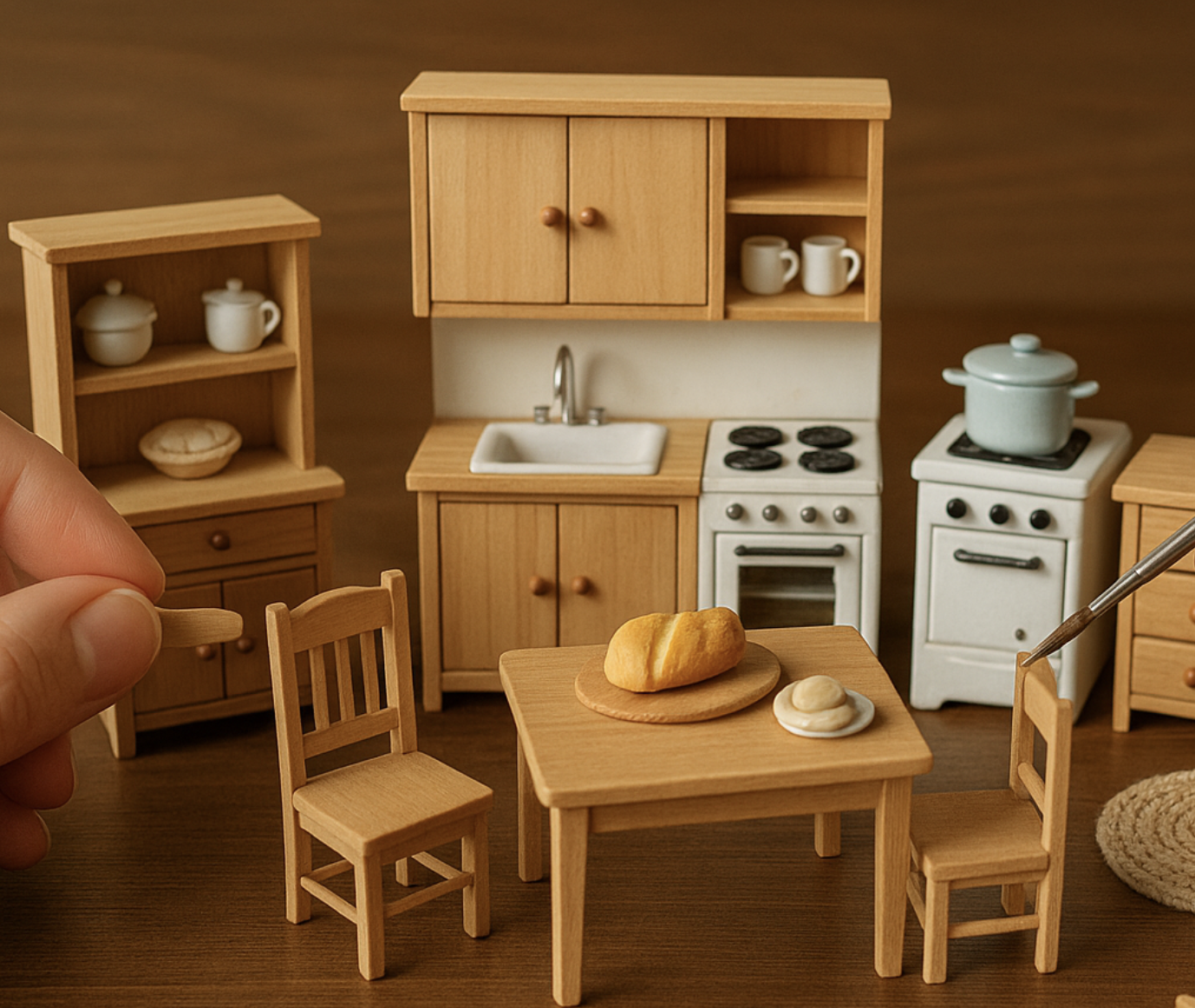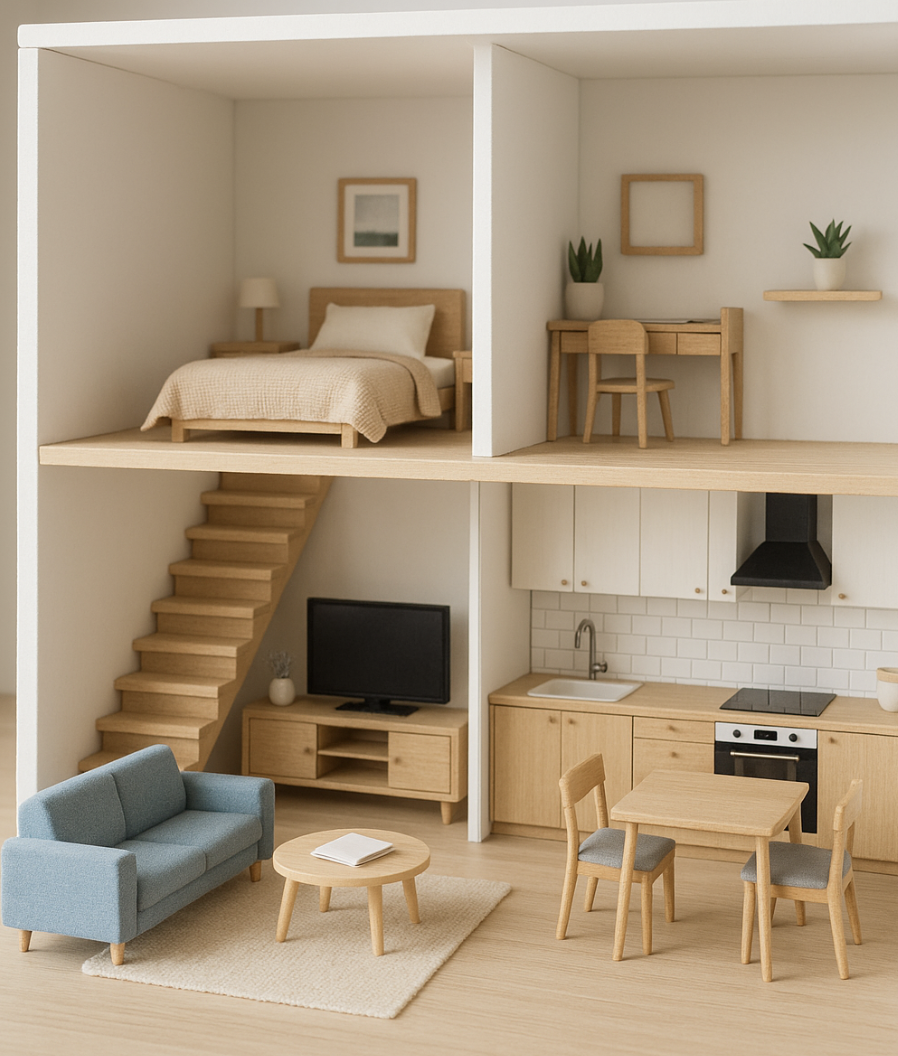How to Start Your Own Miniature Set (And Fall in Love with the Tiny)
There’s a quiet revolution happening in pockets and corners across the world.
In bedrooms. In basements. On cluttered kitchen tables.
People are building worlds that can fit inside a shoebox.
Tiny bakeries with croissants made of clay.
Little record stores with one-inch vinyls stacked alphabetically.
Libraries smaller than a matchbook, with real pages you can turn…if you have the fingertips of a sparrow.
This isn’t just crafting. It’s something more sacred.
It’s memory-work. Therapy. Intimacy made tangible.
To start your own miniature set is to say: I believe in the power of small things.
And in a world that tells us to be bigger, louder, faster…
That’s radical.
Here’s how to begin. Gently. Slowly. With reverence.
Step One: Choose the World You Want to Enter
Before you start snipping felt or buying balsa wood, close your eyes.
Ask yourself:
What little world do I long to live inside?
Maybe it’s a French patisserie with a tiny baguette cooling on the counter.
Maybe it’s a woodland cabin, complete with a teacup fireplace and a leaf-shaped rug.
Maybe it’s your childhood bedroom, remade in miniature, with the same blue walls and that crooked poster that kept peeling in the corner.
You don’t need blueprints. You need longing.
Start with a feeling.
Let your imagination stroll through that tiny door before your hands begin to build.
The best miniature sets don’t replicate the real world.
They recreate emotionally truer ones.
Step Two: Begin Smaller Than Small
You don’t need a whole dollhouse to start.
Begin with a shelf. A room. A chair.
Begin with a breakfast scene, a thimble mug, a sliver of jammed toast, an egg as small as a raindrop.
Starting small gives you permission to fall in love slowly.
It also teaches you the truth of miniatures: detail matters more than scale.
You can spend three hours making one perfect armchair, and it will feel like meditation. Like therapy. Like prayer with glue.
Don’t aim to finish. Aim to feel.
Let the work take the time it needs.
You’re not just making a set.
You’re making space…for focus, for quiet, for yourself.
Step Three: Learn the Language of Scale
Miniatures speak a language of ratios.
The most common is 1:12 scale, where one inch in miniature equals one foot in real life.
There’s also 1:6 (Barbie and fashion dolls), 1:24 (half-scale), and the impossibly delicate 1:144 (used in dollhouses inside dollhouses).
But the truth? You don’t need to speak this language fluently to begin.
Think of scale like rhythm in poetry: helpful, but bendable.
It’s more important that your pieces feel like they belong together than that they follow exact math.
Choose a scale loosely and let your heart be the ruler.
Some makers even blend scales on purpose, exaggerating certain elements to highlight emotion, texture, or humor. A giant cat beside a tiny bookshop. A room with oversized plants, like a jungle for dolls.
You’re building a world, not an engineering project.
Let the scale be your guideline, not your rule.
Step Four: Gather Your Tools of Tenderness
You don’t need a fancy workshop.
But you will need a few tiny allies:
Essential tools:
Tweezers (you’ll bless these daily)
Tacky glue (dries clear and flexible)
Paintbrushes (the thinner, the better)
Toothpicks, Q-tips, cotton swabs (trust me)
Optional magic-makers:
Polymer clay (for food, vases, figures)
Balsa wood (light, cuttable, and lovely)
Felt, lace, fabric scraps (the more textured, the better)
Beads, buttons, bottle caps (tiny treasure potential)
What you’ll discover is this: the world is full of miniature materials.
A twist tie becomes a hose.
A push pin becomes a lamp.
A single sequin becomes a dinner plate.
Miniature work trains your eyes to see again.
To look at trash and think: story.
Step Five: Let Your Fingers Learn
Miniatures are built not just with supplies, but with patience.
At first, your hands will fumble.
The glue will string like cobwebs.
The paint will smudge. The wallpaper will wrinkle.
Good. That’s how you know you’re learning.
This is not the kind of craft you master in a weekend.
It’s a conversation between your fingers and your focus.
Over time, you’ll learn how much glue is too much.
How to brace a delicate frame while it dries.
How to twist a strand of thread into a believable baguette crust.
You’ll get better. But better was never the point.
Presence was.
Step Six: Explore What’s Possible (Without Buying Everything)
You can make entire miniature sets from cardboard and imagination.
But if shopping lights your heart up, there’s nothing wrong with that either.
Just go slow.
Buy the things that delight you, not just the things that check a box.
Some dopamine-igniting finds on Etsy:
Miniature potted succulents – perfect for any style of room
Tiny food sets with stunning detail – from pancakes to sushi
Miniature books with real spines and stitched pages
Handmade 1:12 scale furniture kits
Your first few items will likely become sentimental. Not because they’re perfect, but because they’re yours.
Tiny objects with soul.
Step Seven: Practice the Craft of Belonging
Miniatures are inherently about placement.
Not just making, but making things belong.
Where should the table go? What’s outside the window? What kind of story lives in this room?
When you build a miniature set, you’re not just creating objects.
You’re curating a world where everything has a reason to be.
And in doing that…
You teach yourself that you, too, deserve space.
That you deserve to be in rooms that fit you.
That you can design your life with intention, even if it’s just an inch at a time.
Step Eight: Embrace Emotion as a Material
Miniatures often stir up emotion.
A dollhouse reminds you of your grandmother’s.
A tiny cradle brings tears after a loss.
A school desk makes you ache for a younger self who never quite fit in.
Let that happen.
You’re not just gluing wood and paint. You’re gluing together parts of memory.
Miniatures allow us to externalize emotion safely.
They give shape to things we couldn’t say out loud.
Step Nine: Share It, or Keep It Secret
Once your set is underway, you may feel the urge to share it.
Or you may feel protective.
Both are okay.
If you want to post it online, do! The miniature community is warm, weird, and wildly supportive.
But if you want to tuck it away in a quiet corner of your room (just for you) that’s holy too.
Your miniature set doesn’t need an audience.
It needs a witness. And that can be you.
Step Ten: Let It Grow Organically
You don’t need to “finish” your miniature world.
In fact, you shouldn’t.
Leave space for new ideas. For additions. For evolution.
Maybe the dollhouse gets new curtains next spring.
Maybe the bakery expands to include a rooftop café.
Maybe the tiny garden starts to grow mushrooms sculpted from leftover beads.
Let it live.
Miniatures are like diaries in three dimensions.
They grow with you.
Why This Hobby Heals
Miniature-making isn’t just fun. It’s regulating.
It calms the nervous system.
It reduces racing thoughts.
It draws you into a state of flow, a quiet hum of focus where time forgets itself.
It’s a balm for overstimulation.
A pocket-sized sanctuary in a sprawling world.
And for many of us, that’s not just a hobby.
That’s survival.
Miniatures as a Form of Mindful Repetition
There’s a rhythm to making miniatures that feels almost like breath.
Paint. Dry. Place. Adjust.
Cut. Fold. Glue. Wait.
This kind of repeated, tactile action gently activates dopaminergic flow while mimicking the same neurological calm that comes from knitting, gardening, or walking in a quiet pattern. It’s not passive.
It’s present.
Miniature-making teaches you the art of micro-rituals…those tiny, repeated motions that center the body while softening the mind.
And unlike many tasks in life, these rituals end in something beautiful.
A bookshelf. A pie. A bed with folded sheets the size of a bookmark.
That combination: movement + completion + beauty, is neurological gold.
You’re not just decorating a room.
You’re reinforcing your brain’s belief that small steps lead to satisfaction.
And that’s a truth we all need to relearn.
The Joy of Autonomy in a Small World
In the big world, so much is out of our hands.
Deadlines. Rent. News cycles. Weather.
But in a miniature world, you are the architect.
You decide where the light falls, where the window opens, where the teacup lives.
That autonomy gives your brain a much-needed reset.
It reminds you that control doesn’t have to mean rigidity.
It can mean creativity.
It can mean choice.
Research in behavioral science shows that even small doses of self-directed design reduce cortisol and increase dopamine over time.
In your tiny house, things go where you want them to.
And sometimes, that small agency becomes a deep and lasting relief.
The Dopamine of Wonder
Not all dopamine comes from progress. Some of it comes from awe.
The kind of awe that happens when you step back and realize:
“I just made a functioning chandelier out of beads and wire.”
Or “This bookshelf looks real…like, really real.”
Miniatures evoke childlike wonder in adult bodies.
And wonder, as it turns out, increases dopamine, too. It widens the brain’s field of attention and reduces the grip of stress. It tells us that life still holds mystery, and that we helped make some of it.
Every tiny flowerpot.
Every stove knob.
Every rolled towel.
These aren’t just decorative.
They are invitations to marvel.
And marveling is medicine.
A Tiny Future to Look Forward To
One of the most healing aspects of a dopamine hobby is anticipation.
Our brains thrive on what’s next, not just for reward, but for hope.
When you build miniatures, there’s always a new scene, a new room, a new little object waiting just beyond the current moment. That quiet joy of “next time I’ll start the tile floor” or “I’m almost ready to build the café window” gives the brain a future to hold.
Even when life feels messy or uncertain, your miniature project offers a little thread of continuity.
A thread that says:
“You’ll be back. And you’ll make something beautiful again.”
That’s not just dopamine.
That’s devotion.
The Small is Sacred
If the world feels too big lately, start small.
Build a chair.
Then a table.
Then a room where someone tiny might dream.
And in the building, you’ll find something you didn’t know you were missing:
Stillness.
Joy.
A sense of belonging scaled just right for your heart.
Miniatures won’t solve everything. But they will soften things.
And in a time that demands hardness, that softness is revolutionary.

